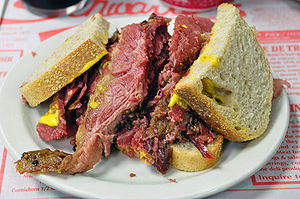Montreal-style smoked meat
 Montreal-style smoked meat from Schwartz's in Montreal | |
| Course | Main course |
|---|---|
| Place of origin | Canada |
| Region or state | Montreal, Quebec |
| Created by | Disputed – various Jewish delis in the city |
| Main ingredients | Smoked meat, mustard, and rye bread |
| Cuisine of Quebec |
|---|
 |
| Part of a series on |
| Canadian cuisine |
|---|
 |
|
|
Montreal-style smoked meat, Montreal smoked meat or simply smoked meat in Quebec (French: viande fumée or even bœuf mariné: Literally “marinated beef”)[1] is a type of kosher-style deli meat product made by salting and curing beef brisket with spices. The brisket is allowed to absorb the flavours over a week. It is then hot smoked to cook through, and finally is steamed to completion. This is a variation on corned beef and is similar to pastrami.
Preparation
[edit]Although the preparation method is similar to that of New York pastrami, Montreal smoked meat is cured in seasoning with more cracked peppercorns and savoury flavourings, such as coriander, garlic, and mustard seed.[2] The recipe for Montreal steak seasoning is based on the seasoning mixture for Montreal smoked meat.
Montreal smoked meat is made with variable-fat brisket, whereas pastrami is more commonly made with the fat-marbled navel/plate cut.[3][4] This is because "navel is much harder to find in Canada because of its British beef cut tradition". The use of brisket means that smoked meat is "not fattier throughout the cut, but it has a larger cap of fat, and it has a stringier texture, more fibrous. American-style pastrami is more marbled with fat and has a denser texture."[5]
Montreal smoked meat is typically served in the form of a light-rye bread sandwich accompanied with yellow mustard. While some Montreal smoked meat is brine-cured like corned beef, with spices applied later, many smoked meat establishments prefer dry-curing directly with salt and spices.
History
[edit]The origins of Montreal smoked meat are uncertain and likely unresolvable. Many have laid claims to the creation or introduction of smoked meat into Montreal. Regardless, all of these stories indicate the creators are of the Jewish Diaspora from Romania or Eastern Europe:
- Some point to Benjamin Kravitz, who founded Bens De Luxe Delicatessen & Restaurant in 1910, as the introducer of Montreal smoked meat. According to the Kravitz family, he used a brisket-curing method he recalled being practised by Lithuanian farmers. His first smoked meat sandwiches were made and sold from his wife's fruit and candy store.[4]
- According to Eiran Harris, a Montreal historian, Herman Rees Roth from New York may have created the first smoked meat sandwich in 1908, selling them from his deli, the British American Delicatessen Store.[4]
- In another claim by Bill Brownstein, the smoked meat was brought over in 1902 by Itzak Rudman, who was an accomplished salami and smoked meat maker who had a shop on de Bullion Street (formerly Cadieux Street).[6]
- In yet another possibility, a butcher by the name of Aaron Sanft who arrived from Iași, Romania, in 1884 founded Montreal's first kosher butcher shop (Sanft Kosher Meat at 560 Craig Street (now Saint Antoine Street)[7]) and likely made smoked meat in the Romanian style similar to pastrama.[8]
Serving
[edit]
Warm Montreal smoked meat is always sliced by hand to maintain its form, since doing so with a meat slicer would cause the tender meat to disintegrate. Whole briskets are kept steaming and sliced up on demand when ordered in the restaurant to maintain its temperature.
Even when hand-cut, Montreal smoked meat produces a considerable amount of broken bits when sliced. These pieces are gathered together and commonly served with French fries, cheese curds, and gravy as smoked meat poutine or served over spaghetti with Bolognese sauce or even pizza.
Montreal-style smoked meat sandwiches are typically built with seedless, light rye bread, and piled with hand-sliced smoked meat about 5 cm (2 in) high with yellow prepared mustard. The customer can specify the amount of fat in the smoked meat:
- Lean: the lean and less flavourful end. Relatively healthful but dry.
- Medium and medium fat: the most popular cuts from the middle of the brisket. Occasionally, a sliced mix of lean and fat meats.
- Old-fashioned: a cut between medium and fatty and often cut a bit thicker.
- Fat: from the fat end of the brisket
- Speck: consists solely of the spiced subcutaneous fat from the whole brisket without meat.
Cultural identity
[edit]Montreal writer Mordecai Richler, in his novel Barney's Version, sardonically described the spices used in the smoked meat at Schwartz's deli as a "maddening aphrodisiac" to be bottled and copyrighted as "Nectar of Judea".[9]
Montreal smoked meat is offered in many diners and fast food restaurant chains throughout Canada.[10] Montreal smoked meat has also been added in to Quebec dishes such as poutine.[11] Along with bagels, smoked meat has been popular in Montreal since the 19th century and is identified as emblematic of the city's cuisine. Despite the food's origins in, and association with, Montreal's Jewish community and, contrary to what is sometimes asserted, delis are seldom certified as kosher.[4]
After the Quebec government passed the Charter of the French Language (Bill 101) in 1977, the Office québécois de la langue française (OQLF) took action against the leading Montreal smoked meat delicatessen retailing imported kosher goods that did not meet its labelling requirements, an action perceived in the Jewish community as an unfair targeting and antisemitism. In particular, Dunn's got in trouble with the OQLF for having the English word, "Smoked Meat" on the sign out front. Dunn's, along with other well-known delicatessen establishments, fought the OQLF's original order to change the name of "Smoked Meat" to "Boeuf Mariné" in order to conform to Quebec Language Law.[12] They won the ruling by appeal by proving that if they didn't advertise "Smoked Meat" they would confuse and anger customers.[13] A good example of this was Parti Québécois MNA Gérald Godin who himself ordered the sandwich by its English name.[14] Due to the work of Myer Dunn, under the new ruling, enacted in 1987, Smoked meat became a word in both Official languages of Canada.[15]
See also
[edit]References
[edit]- ^ "smoked meat". gdt.oqlf.gouv.qc.ca. Retrieved 28 January 2018.
- ^ "Montreal-style Smoked Meat". beef2live.com. Retrieved 2024-01-18.
- ^ "10 Reasons Why Montreal Smoked Meat Is Better Than New York Pastrami". 13 June 2014. Retrieved 7 October 2014.
- ^ a b c d Sax, David (2010-10-01), Save the Deli: In Search of Perfect Pastrami, Crusty Rye, and the Heart of Jewish Delicatessen, Mariner Books, ISBN 978-0-547-38644-7
- ^ "What's the Difference Between Pastrami and Montreal Smoked Meat?".
- ^ Browstein, Bill (2006), Schwartz's Hebrew Delicatessen: The Story, Véhicule Press, ISBN 978-1-55065-212-3
- ^ "Best the Delicious History of Montreal Smoked Meat Recipes, News, Tips and How-Tos". 27 April 2017.
- ^ Rabinovitch, Lara (2009), "Montreal-Style Smoked Meat:An interview with Eiran Harris conducted by Lara Rabinovitch, with the cooperation of the Jewish Public Library Archives of Montreal", Cuizine: The Journal of Canadian Food Cultures / Cuizine: Revue des cultures culinaires au Canada, 1 (2)
- ^ Richler, Mordecai (1999-03-01), Barney's Version, Washington Square Press, ISBN 978-0-671-02846-6 "You know if you had really, really been intent on entrapping me on my wedding night, you wicked woman, you would not have dabbed yourself with Joy, but in Essence of Smoked Meat. A maddening aphrodisiac, made from spices available in Schwartz's delicatessen. I'd call it Nectar of Judea and copyright the name".
- ^ "Home and Kitchen Appliances - Grinder Reviewed". Grinderreviewed.com. Retrieved 28 January 2018.
- ^ "Best Montreal Poutine Restaurants". 10 January 2014. Retrieved 7 October 2014.
- ^ "The Montreal Gazette – Google News Archive Search". Retrieved 2 March 2016.
- ^ "Ottawa Citizen – Google News Archive Search". Retrieved 2 March 2016.
- ^ Macdonell. "The Montreal Gazette – Google News Archive Search". Retrieved 2 March 2016.
- ^ "Ottawa Citizen – Google News Archive Search". Retrieved 2 March 2016.
